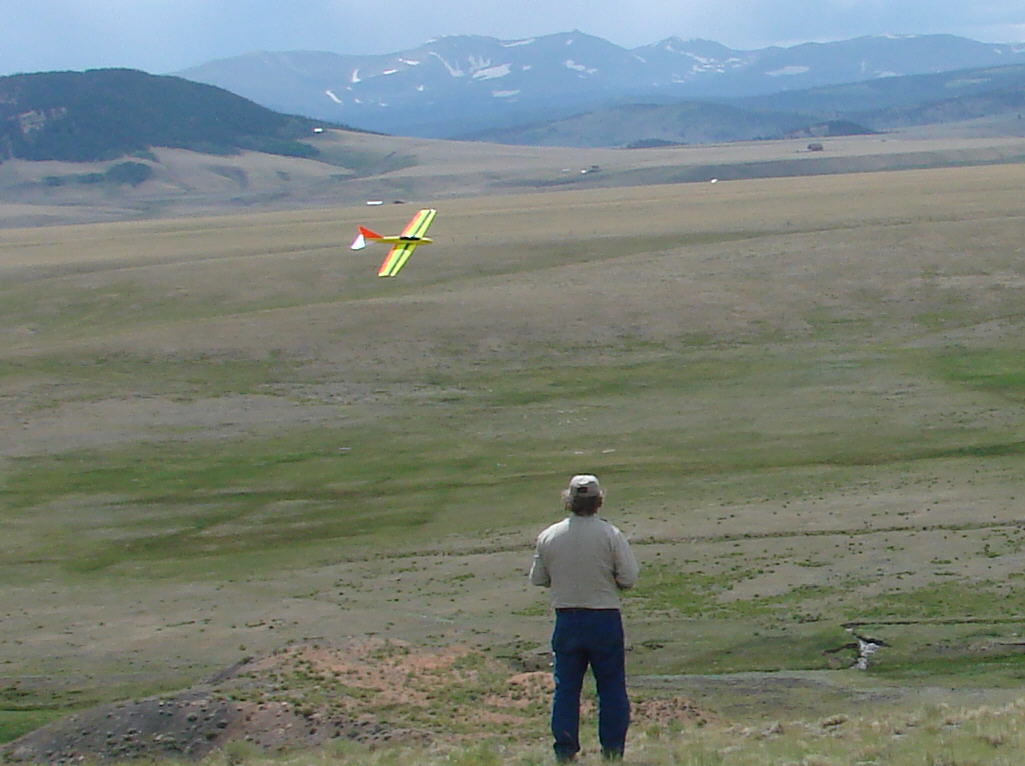
Please be patient while these photos load- I wanted to offer everyone a good look at this design, and one of the plane in the air at the KING slope flying site. I hope you enjoy all of them!
The photos and information below offer a good look at an incredible flying aircraft!






Here's a look at the wing and fuselage during construction, showing the spars, hard balsa triangular sub-trailing edge, and the metal gear servo placements. The ballast compartment has not yet been cut in the EPP foam fuselage, and the wing mounting reinforcing fiberglass plates and balsa blocking have not yet been added. More carbon fiber tow was also overlaid at the wing's center at the trailing edge to give it further strength before the wing received it's nylon filament tape treatment.
Wingspan : 48" EPP foam, with a one piece 48" .230 tubular Carbon Fiber spar on bottom surface, and a flat CF spar set in vertically on top; plus 4 more CF rod center section spars and some CF tow.
Fuselage Length: 33" of EPP foam; 35.625" to the t.e. of the elevator. four CF rods embedded in the aft fuselage to maintain alignment & rigidity with minimal weight.
Wing Chord : 10.25" center, tapered to 6.875" at wing tips
Wing Area : 390 square inches flying surface area = 2.7 square feet
Airfoil: SD6060
Wing Layout" -flat built, no dihedral; Full Strip Ailerons 1.5" wide, inset from wing tips
Controls: Ailerons and Elevator; Dual Aileron servos allow Spoileron deployment for landing
Minimum Flying Weight, Sloper configuration: 26.125 Ounces (ballastable to 36.375 Oz.) when built with 3 SSV-9314MG metal gear servos
Wing Loading : 9.68 Oz. per square foot minimum; 13.47 Oz. per square foot maximum with 10.25 Oz. Ballast weight in compartment
Radio System used: Airtronics RD8000 Super Transmitter; GWS 8 Channel Dual Conversion Receiver; three 15 gram Metal Geared servos; 5 cell 850 mAH Nicad Receiver pack.
Since it's built entirely of the very resilient EPP foam with Coroplast tail members, it can fly and land *Anywhere* without sustaining noticeable damage, even with rough landing conditions at rocky or sage brush covered sites.
The wing on this one is detachable, mounted to the fuselage with 4 #8 pan head sheet metal screws running through 1/32" fiberglass plates & balsa filler blocks in the wing, which then fasten into 1/8" birch ply plates that are epoxied into the EPP foam. Nylon filament tape wraps the fuselage to complete the securing of the wing mount plates. (In building my own EPP aircraft, I prefer to work with epoxy, which outgasses less volatiles, as I am personally sensitive to solvent based glues; others use GOOP and a variety of other adhesives.)
Glide? You bet! The SD6060 is an ideal airfoil for this design; it's one of the top slope soaring airfoils in use. It's definitely performing to my expectations. And besides handling smoothly in heavy and gusty winds, the glide in light air is great, too. The flat-built high performance wing on the prototype VARRKAIN leaves the pilot flying the aircraft more attentively than might be the case if the wing were built with ~2" of dihedral.
Bad Habits? I don't detect any at all. It recovers very quickly when flown into a stall in light lift, with no tendency to drop off into a spin.
A few more details: I cut the wing cores for the VARRKAIN from 1.3 pound density EPP foam, using the SD6060 airfoil for this wing. I used a band saw to do the 1.3 pound density EPP foam fuselage's major shaping, before going to the fillet knife & sanding blocks to complete the final shaping.
The 5 cell AA NiCad receiver pack in the sloper nose contributes some substantial weight, just where it's needed, well forward in this nose section. There's presently 5-1/8 ounces of balancing weight, in the form of sheets of 1/16" thick lead, in spaces just above as well as just in front of the battery in this sloper nose. Flying weight at 26-1/8 ounces is at a good weight for slope soaring with this size aircraft in light winds, giving it a wing loading of ~9.7 Ounces per square foot. Ballast weight for flying heavier winds is quickly and easily added in place into the compartment inside the fuselage just on top of the main wing spars by simply rmeoving the 4 wing mounting screws, inserting the ballast weight, then reinstallnig the wing mount screws.
Oh, the name? It's my own unique name for this design. There's a similar Finnish word, varkain, which loosely translates to "secretly, surreptitiously, stealthily" ; .... maybe hinting at the Varrkain's nature- a slope combat ship which might initially be under-estimated... but only at your opponent's peril !! (grin)
More flight reports and details later!!